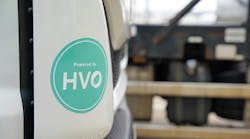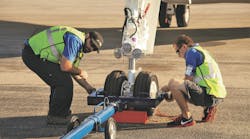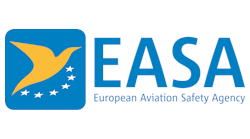Aircraft deicing has been going on since the advent of flying in some form or fashion. In the early days aircraft were deiced in a pure mechanical operation. The control surfaces were scraped or brushed or both in many cases. As time and technology progressed, so did the cleaning of the aircraft.
In the 1950s the industry moved toward the use of deicing solutions. By the 1960s, commercial aviation had accepted the use of deicing solutions utilizing hot water and some mixture of glycol. It was during this era that inventors such as Ted Trump and the engineers at the John Bean Co. emerged. These inventors manufactured some of the first aircraft deicers of a vehicular design that incorporated the use of aerial devices to spray the aircraft with a heated fluid. This fluid was heated to almost boiling and then utilized to remove any frozen precipt from the control surfaces, fuselage and flight instruments. As the equipment evolved, so did the use of other equipment from the fire fighting industry. Fluid pumps and spray nozzles were both adapted. The use of hot fluid applied at a pressure of 150 psi with an adjustable flow of 20 to 60 gallons per minute became the norm in the aviation community. Many operators simply drowned the aircraft with 60 GPM of fluid when, in reality, 20 to 30 GPM would get the job done just as fast.
Operators were trained and re-trained, as most of the industry deicing was an infrequent occurrence. Only Mother Nature would determine the need for deicing. Deicing equipment was usually readied for service in September of each year with the utilization continuing through April 15. The season would vary depending on the location. In the early years aircraft mechanics would usually perform the deicing function. This was the norm until well into the 1970s, when some commercial airlines trained specific employees to perform the function. However, it was always and still is the captain’s responsibility to ensure the aircraft is clean and ready for flight.
As the technology and equipment progressed, so did the aircraft and the rest of the industry. By the early 1980s, a large part of the aviation industry was using pre-mix fluid ratios and spraying the heated solutions onto the aircraft to clean them for flight. Everyone seemed pretty content with the way the industry was working and things were good.
Then entered the EPA and the recognition that ethylene glycol was an environmental hazard. Millions of gallons of this fluid were sprayed around the world each year. It was soon realized that propylene glycol was not nearly as harmful to the environment and thus the industry switched to spraying propylene. Even with the change to propylene, there was a large amount of discussion regarding the reclamation of sprayed fluid. This continues today and is monitored closely at airports throughout the world. Many airports are reclaiming sprayed glycol and making it ready for re-use. Technology continues to improve this operational capability with many companies working on improving the reclamation of fluid.
Anti-icing fluid entered the deicing scene first in Europe and then in the mid to late 1980s in the US. This fluid was designed to coat the control surfaces and absorb falling precipt for a given time period. During this time frame, the aircraft would taxi out and on take-off roll, the fluid would begin to shear off the control surfaces at 80 knots, providing a clean wing for flight. This fluid was known as Type II and was made by a few chemical companies. The use of Type II fluid posed a problem for the equipment manufacturers in that the fluid was fragile and had to be handled and applied to the aircraft in a very specific manner. By the early 1990s, Type II fluid was widely accepted and used throughout the United States.
Another significant development in the late 1980s was the introduction of using forced air to clean aircraft surfaces. Unlike the acceptance of Type II, the utilization of forced air to clean aircraft would take much longer than the thickened fluid. Research and development went on for many years and, largely thanks to the efforts of Mr. Lee Williams, has finally been accepted. Lee was instrumental in the development of this system and today holds a patent on the nozzle used by most US manufacturers. This patent was obtained by working with the engineers at Wright Patterson Air Force Base.
Since the acceptance of forced air, manufacturers have continued to enhance this form of deicing by injecting small amounts of fluid, both heated and nonheated. The results have been quite successful and a significant reduction in the amount of fluid used has been reported in some deicing applications.
In the mid 1990s Type II fluid was replaced by Type IV fluid. This new fluid had the same characteristics as the Type II fluid, but was not nearly as fragile. The Type IV fluid can be handled without the fear of destroying its usefulness.
Today the manufacturers of both fluid and equipment strive to improve their products while maintaining the focus of flight safety. With the use of technology, equipment continues to become more specific in design and functionality. Everything from small pre-mix trailer deicers, to truck-mounted, to purpose-built specialty machines, are produced to keep the aviation community flying safely. The units of tomorrow will continue to be enhanced and refined to perform their function with the upmost efficiency.



